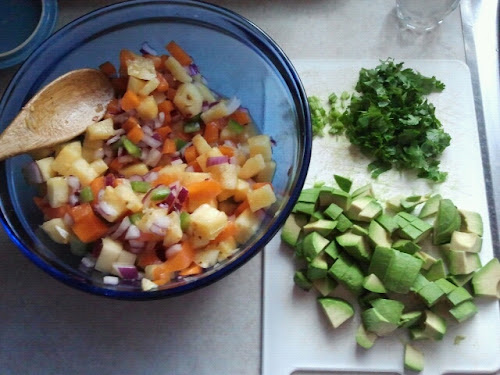I am working my way through the summer edition of Food and Drink. Yesterday, I decided to make Jamaican Jerk pork tenderloin, along with some pineapple avocado salsa. My kids ate the potatoes, which is a start. I even omitted the pepper from the jerk spice marinade so they could try the meat, but they decided to be vegetarian last night. Now, we have enough leftovers for the rest of the week. I need to start freezing stuff.
I had all the ingredients on hand for the jerk marinade except for the pepper, so it worked out well. Everything was chopped up in my mini food processor, starting with the onion, then the garlic, liquids and spices. The weird thing was, after the meat was cooked, the marinade did not taste like much. It has lots of ingredients, and many of them are quite strong, aromatically (garlic, cinnamon, all spice, nutmeg and ginger). Most of the flavour comes from smelling the spices prior to eating. Our brain works very hard during the act of tasting. To find out more, check out the CBC Radio One program called Think About It, the Neurogastronomy episode.
Anyway, the supper was fairly easy to make once the meat was marinading. The pineapple salsa called for chopping up a full pineapple, but you could reduce your work by using a peeled and cored pineapple if you choose. The salsa is supposed to sit for at least an hour prior to eating, and the meat should marinate at least four hours ahead. Both can be prepared the day ahead for even better flavour, so not a spur of the moment recipe.
Jerk Pork
2 pork tenderloins, trimmed of fat
1/2 large onion, coarsely chopped
3 large garlic cloves
Scant 1/4 cup each of vegetable oil, soy sauce, lime juice, and brown sugar
2 tbsp chopped fresh ginger
1 jalapeño pepper, thinly sliced with seeds
1 tbsp dried thyme
1/2 tbsp each ground cinnamon and allspice
1 tsp each ground nutmeg, craked black pepper and salt.
After trimming the fat and silver skins from the tenderloins, place the meat on a cutting board. Use a large fork to poke through the tenderloins. Make about 20 inserts throughout each tenderloin, ensuring that the fork goes through to the cutting board. Place the tenderloins in a large freezer bag or a shallow dish.
Put all the other ingredients in a food processor to make the marinade. Since I had a small chopper, I started with the onion, then garlic. I waited until the onion was chopped enough so there was room to add the remaining ingredients. Mix until everything is evenly ground.
Pour the marinade over the meat in the bag. Massage the marinade all over the meat. Remove as much of the air from the bag before sealing. Place the bag in a dish and let sit in the refrigerator for at least four hours, preferably 24 hours. If the meat is in a dish, cover the meat before putting it in the refrigerator. Turn the meat occasionally to distribute the marinade.
You can roast the pork on a foil lined baking sheet at 350F for 40 to 55 minutes. Alternately, you can wrap the tenderloins in foil and cook on the barbecue for 40 minutes. The internal temperature at the thickest part should read 155F. Remove the pork from heat and let sit for five minutes before cutting. You can serve it the next day, just wrap the whole tenderloin and refrigerate for up to one day.
Serve with Pineapple Avocado salsa.
Pineapple Avocado Salsa
1 fresh pineapple, peeled cored and chopped into bite sized pieces
1 large red or orange pepper, chopped
1/2 cup finely chopped red onion
Juice of two large limes
2 tbsp olive oil
1tbsp granulated sugar
1 tsp dried chili flakes or 1 to 2 tbsp finley chopped and seeded jalapeño pepper
1/2 tsp salt
2 ripe, but firm Haas avocados
1 cup chopped cilantro leaves
Mix together the diced pineapple, red pepper and red onion. In a separate bowl, mix together the dressing ingredients (everything but the avocados and cilantro). Pour over the pineapple mixture and set aside for at least one hour before serving, stirring occasionally.
Just before serving, drain off the liquid. Dice the avocado and stir into salsa along with the chopped ciltantro.
Barbecued Potatoes
It is up to you to determine how many potatoes you want to bake. You can use mini or regular sized potatoes. Slice them, but not all the way through, so they kind of look like an accordion. Top them with butter (or some oil/fat), spices (I used no salted added Montreal Steak Spice), and salt if needed. Wrap in foil, and cook on the barbecue.
Like I said, this meal requires marinating time, but once everything is "stewing" it comes together quickly. It is a very tasty meal, and the combination of spices is perfect for hot summer dining.






No comments:
Post a Comment